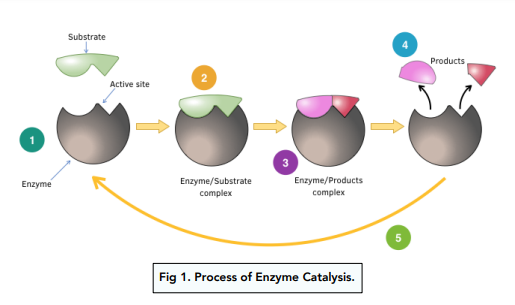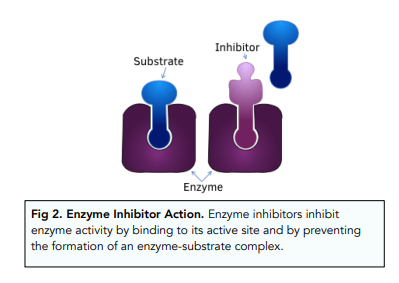Amino Acids, Proteins and DNA - Enzyme Action (A-Level Chemistry)
Enzyme Action
Enzymes
Enzymes are globular proteins with a specific shape due to the tertiary structure of their polypeptide chains.
Enzymes are biological catalysts: they speed up reactions in living organisms so they can occur in seconds instead of hundreds of years.
Enzymes are extremely specific.
Enzymes as Catalysts
Enzymes speed up the chemical reactions that take place in the body by lowering the activation energy required.
The molecule the enzyme catalyses is called the substrate. The process by which the enzyme does so goes as follows:
1. Substrate binding. Enzyme shape usually includes a cleft or crevice called the active site of an enzyme, where the substrate can fit perfectly and where the reaction between substrate and enzyme occurs.
2. Formation of an enzyme-substrate complex. The substrate temporarily bonds to the active site of an enzyme by intermolecular forces. The structure formed is called the enzyme-substrate complex.
3. Enzyme catalyses the reaction. The interactions between the enzyme and the substrate weaken the bonds within the substrate molecule so that less energy is needed to break them. The enzyme therefore catalyses the reaction involving the substrate to form products. The products remains bonded to the enzyme in an enzyme-product complex.
4. Product release. The bonds between the enzyme and the products break so that the products formed from the reaction are ejected.
5. Enzyme recycling. The enzyme is left unchanged from the reaction and is free to be used again.

The 3D structure of an enzyme is very specific so only one substrate molecule will bind to that one enzyme.
For this reason, enzymes can be stereospecific. This means their active site (tertiary structure) is so specific it will only bind to one or the other enantiomer.
Enzyme Inhibition
• Enzyme inhibitors slow down enzyme activity. Inhibitors can slow down or stop the rate of reaction of a reaction catalysed by an enzyme.
• Enzyme inhibitors block substrate binding. Molecules with similar structure to a substrate is called an inhibitor. The inhibitor can bind to the active site of an enzyme therefore blocking the substrate from binding.

• Increasing substrate concentration reverses the effects of inhibitors. Increasing the substrate concentration can decrease the effect of an enzyme inhibitor as it can compete with the inhibitor to bind to the enzyme active site.
• Enzyme inhibitors can be used in medicine. Many drugs which treat diseases caused by micro-organisms, operate by inhibiting their enzymes. Scientists have vast knowledge of protein structures and can use this in computer modelling to design drugs that can be used to treat certain medical conditions.





Still got a question? Leave a comment
Leave a comment